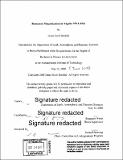Remanent magnetization in angrite NWA 4931
Author(s)
Berdahl, James Scott
DownloadFull printable version (2.805Mb)
Other Contributors
Massachusetts Institute of Technology. Department of Earth, Atmospheric, and Planetary Sciences.
Advisor
Benjamin Weiss.
Terms of use
Metadata
Show full item recordAbstract
Angrites are among the oldest known rocks and may record planetesimal dynamo activity and protoplanetary disk fields in the early solar system. Towards this goal, the natural remanent magnetism and its origin were examined in newly discovered angrite NWA 4931. Measurements were conducted on subsamples cut from various distances along a drilled core sample of the meteorite. The samples were then progressively demagnetized to isolate primary magnetization from contaminant overprints and to calculate paleofield intensity. Dust produced during the subsampling process was analyzed to determine that the mineralogical source of the magnetism was magnetite. Analyses of fusion crusted and adjacent samples showed that the exterior of the meteorite had been contaminated by a collector's hand magnet. However, the interior of the core yielded a pristine record, indicative of a paleointensity strength on the order of 25 [mu]T. These results, in light of magnetic measurements on other angrite samples, are suggestive of a core dynamo active for at least seven million years on the angrite parent body, beginning by 4564 Ma.
Description
Thesis: S.B. in Geoscience, Massachusetts Institute of Technology, Department of Earth, Atmospheric, and Planetary Sciences, 2008. Cataloged from PDF version of thesis. Includes bibliographical references (pages 26-27).
Date issued
2008Department
Massachusetts Institute of Technology. Department of Earth, Atmospheric, and Planetary SciencesPublisher
Massachusetts Institute of Technology
Keywords
Earth, Atmospheric, and Planetary Sciences.